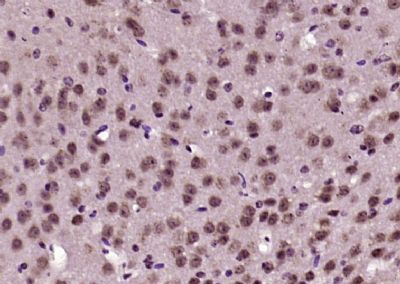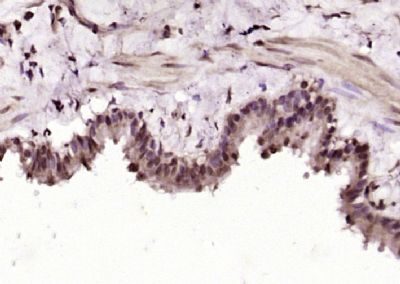The transcription factor NFkB is retained in the cytoplasm in an inactive form by the inhibitory protein IkB. Activation of NFkB requires that IkB be phosphorylated on specific serine residues, which results in the targeted degradation of IkB (1). IkB kinase alpha (IKK alpha), previously designated CHUK (2), interacts with IkB-alpha and specifically phosphorylates IkB-alpha on the sites that trigger its degradation, serines 32 and 36 (3). IKKalpha appears to be critical for NFkB activation in response to proinflammatory cytokines (4). Phosphorylation of the IkB by IKK alpha is stimulated by the NFkB inducing kinase (NIK), which itself is a central regulator for NFkB activation in response to TNF and IL-1 (5). The functional IKK complex contains three subunits, IKK alpha, IKK beta and IKK gamma (also designated NEMO), and each appears to make essential contributions to IkB phosphorylation (6). IKAP (IKK-complex-associated protein) is a protein that acts as a scaffold, interacting with NIK, IKK alpha and IKK beta and assembling them into an active kinase complex (7,8)
Function:
May act as a scaffold protein that may assemble active IKK-MAP3K14 complexes (IKKA, IKKB and MAP3K14/NIK).
Acts as subunit of the RNA polymerase II elongator complex, which is a histone acetyltransferase component of the RNA polymerase II (Pol II) holoenzyme and is involved in transcriptional elongation. Elongator may play a role in chromatin remodeling and is involved in acetylation of histones H3 and probably H4.
Subcellular Location:
Cytoplasm. Nucleus.
DISEASE:
Defects in IKBKAP are the cause of hereditary sensory and autonomic neuropathy type 3 (HSAN3) [MIM:223900]; also known as Riley-Day syndrome or familial dysautonomia (FD). This autosomal recessive disorder is due to the poor development and survival, and progressive degeneration of the sensory, sympathetic and parasympathetic neurons. HSAN3 individuals are affected with a variety of symptoms such as decreased sensitivity to pain and temperature, cardiovascular instability, recurrent pneumonias, vomiting crises, and gastrointestinal dysfunction. It is primarily confined to individuals of Ashkenazi Jewish descent, with an incidence of 1/3'600 live births.
Similarity:
Belongs to the ELP1/IKA1 family.
SWISS:
O95163
Gene ID:
8518
Database links:
Entrez Gene: 8518 Human
Entrez Gene: 230233 Mouse
Entrez Gene: 10000972 Rabbit
Entrez Gene: 140934 Rat
Omim: 603722 Human
SwissProt: O95163 Human
SwissProt: Q7TT37 Mouse
SwissProt: Q8WND5 Rabbit
| Picture |
Paraformaldehyde-fixed, paraffin embedded (mouse brain); Antigen retrieval by boiling in sodium citrate buffer (pH6.0) for 15min; Block endogenous peroxidase by 3% hydrogen peroxide for 20 minutes; Blocking buffer (normal goat serum) at 37°C for 30min; Antibody incubation with (IKAP) Polyclonal Antibody, Unconjugated (SL13644R) at 1:200 overnight at 4°C, followed by operating according to SP Kit(Rabbit) (sp-0023) instructionsand DAB staining.
Paraformaldehyde-fixed, paraffin embedded (rat lung); Antigen retrieval by boiling in sodium citrate buffer (pH6.0) for 15min; Block endogenous peroxidase by 3% hydrogen peroxide for 20 minutes; Blocking buffer (normal goat serum) at 37°C for 30min; Antibody incubation with (IKAP) Polyclonal Antibody, Unconjugated (SL13644R) at 1:200 overnight at 4°C, followed by operating according to SP Kit(Rabbit) (sp-0023) instructionsand DAB staining.
|
|
|

